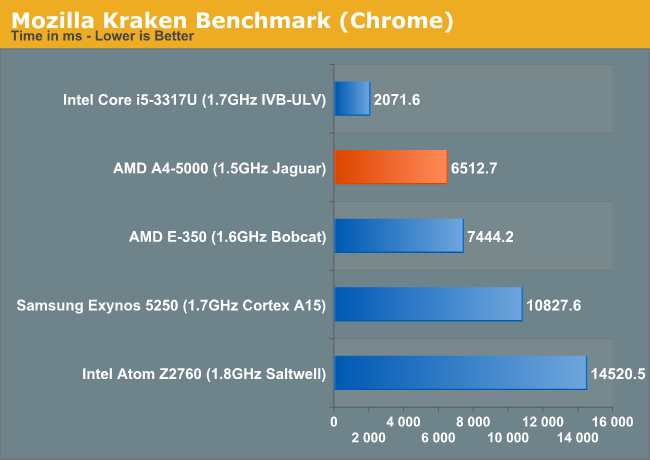The AMD Kabini Review: A4-5000 APU Tested
by Jarred Walton on May 23, 2013 12:00 AM ESTKabini vs. Clover Trail & ARM
Kabini is a difficult SoC to evaluate, primarily because of the nature of the test system we're using to evaluate it today. Although AMD's Jaguar cores are power efficient enough to end up in tablets, the 15W A4-5000 we're looking at today is a bit too much for something the size of an iPad. Temash, Kabini's even lower power counterpart, will change that but we don't have Temash with us today. Rather than wait for AMD to get us a Temash based tablet, I wanted to get an idea of how Jaguar stacks up to some of the modern low-power x86 and ARM competitors.
To start, let's characterize Jaguar in terms of its performance compared to Bobcat as well as Intel's current 32nm in-order Saltwell Atom core. As a reference, I've thrown in a 17W dual-core Ivy Bridge. The benchmarks we're looking at are PCMark 7 (only run on those systems with SSDs), Cinebench (FP workload) and 7-Zip (integer workload). With the exception of Kabini, all of these parts are dual-core. The Atom and Core i5 systems are dual-core but have Hyper-Threading enabled so they present themselves to the OS as 4-thread machines.
| CPU Performance | ||||||||||||||||
| PCMark 7 | Cinebench 11.5 (Single Threaded) | Cinebench 11.5 (Multithreaded) | 7-Zip Benchmark (Single Threaded) | 7-Zip Benchmark (Multithreaded) | ||||||||||||
| AMD A4-5000 (1.5GHz Jaguar x 4) | 2425 | 0.39 | 1.5 | 1323 | 4509 | |||||||||||
| AMD E-350 (1.6GHz Bobcat x 2) | 1986 | 0.32 | 0.61 | 1281 | 2522 | |||||||||||
| Intel Atom Z2760 (1.8GHz Saltwell x 2) | - | 0.17 | 0.52 | 754 | 2304 | |||||||||||
| Intel Core i5-3317U (1.7GHz IVB x 2) | 4318 | 1.07 | 2.39 | 2816 | 6598 | |||||||||||
Compared to a similarly clocked dual-core Bobcat part, Kabini shows a healthy improvement in PCMark 7 performance. Despite the clock speed disadvantage, the A4-5000 manages 22% better performance than AMD's E-350. The impressive gains continue as we look at single-threaded Cinebench performance. Again, a 22% increase compared to Bobcat. Multithreaded Cinebench performance scales by more than 2x thanks to the core count doubling and increased multi-core efficiency. The current generation Atom comparison here is just laughable—Jaguar offers more than twice the performance of Clover Trail in single threaded Cinebench.
The single threaded 7-Zip benchmark shows only mild gains if we don't take into account clock speed differences. If you normalize for CPU frequency, Jaguar is likely around 9% faster than Bobcat here. Multithreaded gains are quite good as well. Once again, Atom is no where near AMD's new A4.
The Ivy Bridge comparison is really just for reference. In all of the lightly threaded cases, a 1.7GHz Ivy Bridge delivers over 2x the performance of the A4-5000. The gap narrows for heavily threaded workloads but obviously any bigger core going into a more expensive system will yield appreciably better results.
For the next test I expanded our comparison to include an ARM based SoC: the dual-core Cortex A15 powered Samsung Exynos 5250 courtesy of Google's Nexus 10. These cross platform benchmarks are all browser based and run in Google Chrome:

Here we see a 14% improvement over Bobcat, likely closer to 20% if we normalized clock speed between the parts—tracking perfectly with AMD's promised IPC gains for Jaguar. The A4-5000 completes the Kraken benchmark in less than half the time. The 1.7GHz Ivy Bridge part is obviously quicker, but what's interesting is that if we limit the IVB CPU's frequency to 800MHz Kabini is actually a near identical performer.
Jaguar seems to be around 9-20% faster than Bobcat depending on the benchmark. Multithreaded workloads are obviously much better as there are simply more cores to run on. In practice, using the Kabini test system vs. an old Brazos machine delivers a noticeable difference in user experience. Clover Trail feels anemic by comparison and even Brazos feels quite dated. Seeing as how Bobcat was already quicker than ARM's Cortex A15, its no surprise that Jaguar is as well. The bigger problem here is Kabini needs much lower platform power to really threaten the Cortex A15 in tablets—we'll see how Temash fares as soon as we can get our hands on a tablet.










130 Comments
View All Comments
Spunjji - Friday, May 24, 2013 - link
Ah, so that justified them doing it while they did do that, right? ;)Coolmike899 - Thursday, May 23, 2013 - link
I know it's not on topic, but did anyone else see the add for the GTX 780 on anand's home page?coburn_c - Thursday, May 23, 2013 - link
Only one test comparing it against an a15? There is trickery afoot.wumpus - Saturday, May 25, 2013 - link
Or likely a lack of A15 based systems in Anand's test lab. HEY YOU! You with the A15 tablet samples. Send some to Anand.beginner99 - Thursday, May 23, 2013 - link
looks ok now...but this will change in about 1 month and then even more so when baytrail-T arrives.devashishpurandareva - Thursday, May 23, 2013 - link
The article describes a 14 inch display, but the specs embedded in the article mention 15.6 inch screen...JarredWalton - Thursday, May 23, 2013 - link
Fixed.coburn_c - Thursday, May 23, 2013 - link
A4-5000: half the performance of Haswell with all the TDPtakeship - Thursday, May 23, 2013 - link
It's even worse than that. Kabini can't compete in either CPU, or GPU perf with ULV Ivy-bridge, let alone Haswell. Less performance, slightly better battery life?, and likely cheapy cheap laptops sound the DO NOT WANT trumpet pretty loudly. Maybe if we could get this kind of performance at 7W instead.NotTarts - Thursday, May 23, 2013 - link
Kabini will be priced under $60. What's Haswell going to be priced at again? $200? $300?